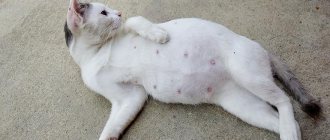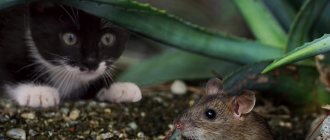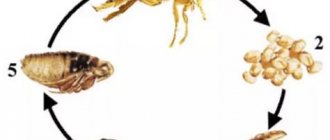Having discovered fleas on a cat, many owners select relatively cheap folk remedies for treatment. In terms of effectiveness, they are often not inferior to expensive and advertised ones, but are less dangerous to the health of the animal.
Tar soap is an excellent option in the fight against external parasites. To successfully use soap, it is important to study its composition, properties and basic rules of use.
Is it suitable for cats?
In addition to special shampoos intended for hair and skin care, there are drugs whose action is aimed at destroying parasites or fungus. Many cat owners refuse pharmaceutical products, preferring tar soap, because... this product has a number of useful properties.
When used correctly, this soap accelerates the process of cell regeneration and relieves irritation of the epidermis. It has anti-inflammatory and antibacterial effects. The smell of a hygiene product can repel parasites, which serves as a prevention of flea infestation.
But tar soap cannot be used regularly for the procedure either. The choice in favor of this product should be made if there is no special means for washing the animal at home.
Will this soap help?
Does tar soap help get rid of Ctenocephalides canis or Ctenocephalides felis fleas?
Yes, this insecticide instantly and permanently kills fleas on the fur of a cat or dog. With the help of such a product, the pet owner completely destroys all parasites.
However, such treatment of an animal is a labor-intensive process. Ideally, tar soap should sit on dog or cat hair for about 30–40 minutes. with each application to destroy all parasites, but you can reduce this time to 10 minutes.
Composition and beneficial properties
Tar soap has a variety of insecticidal and medicinal properties.
This product consists of the following components:
- birch tar. Birch tar is very toxic to fleas Ctenocephalides canis, Ctenocephalides felis or other parasites. Also, such tar is a good antiseptic that slows down and stops the growth of various bacteria or fungi;
- phenol, cresol and alkali. These chemicals, which are part of the soap, leave various chemical burns on the body of fleas, from which they then die;
- sodium salts, which maintain salt and water balance in the skin.
It is also beneficial to use tar soap when ridding your pet of Ctenocephalides canis or Ctenocephalides felis fleas for the following reasons:
- small price - 20 rubles. for 1 piece At the same time, specialized various products for certain types of fleas cost 10 or more times more;
- such soap is safe for both pets and their owners;
- it does not cause allergies with frequent use.
Does it help remove fleas?
Soap containing birch tar does not provide a 100% guarantee of killing parasites. The product will only be effective under certain conditions. For example, if a cat has been in contact with another animal that has fleas, then preventive treatment is required immediately after a walk.
It is necessary to bathe the pet. If he was infected, then 1 procedure will be enough. Parasites can be washed or combed out. Benzene, which is contained in tar, is a toxin for insects. It affects the nerve centers of fleas. Therefore, the parasites become lethargic (sedentary).
If a cat has a severe flea infestation, then several treatments will be required to treat head lice. The animal must be soaped and wait 5 minutes. During this time, some of the fleas will leave the fur on their own (will end up in the water), while others will become inactive. The remaining parasites are combed out.
But soap only has a negative effect on adults, and not on their eggs. Therefore, it will be necessary to re-treat in a few days when the nits hatch.
Benefits of tar soap
Unlike chemical veterinary preparations, tar soap does not contain poisons, toxins, or other compounds and substances potentially harmful to the animal’s body, does not dry out the skin of animals, and has a beneficial effect on the coat.
Tar soap can be used for bathing animals if the skin has wounds, microcracks, skin rashes, small scratches, or other visible damage to the dermis. Veterinarians recommend using this product for the prevention of dermatitis, dermatoses, and skin infections of fungal etiology. The components of the natural product have a beneficial effect on all structures of the epidermis, have a mild analgesic, drying, and tonic effect.
Tar soap contains exclusively natural ingredients
To combat fleas, tar soap can be used regularly to bathe small kittens, starting from 5-7 weeks of age. Note that insecticidal-acaricidal drops can be used for therapeutic and preventive treatments of animal hair only from two months of age.
Tar soap does not cause side effects. Allergies, urticaria, skin rash, and other uncharacteristic symptoms are noted only in the case of individual intolerance by the animal body to the components of the natural remedy.
In addition, tar soap has an affordable price and can be purchased at any pharmacy in the city.
The only disadvantage of birch tar soap is its low efficiency, especially if your cat has thick, long hair. This product does not so much destroy fleas as simply repel them. Persistent individuals can remain on the body of a furry pet, continuing to cause trouble. Does not destroy flea eggs and other ectoparasites. Therefore, if there is severe infestation, it is worth choosing other, more effective insecticidal agents against ectoparasites for the cat.
Is it effective against lichen?
Tar reduces the activity of bacterial and fungal microflora, so soap containing this element can be used to treat lichen in cats. To cure an animal, apply foam to the affected area and leave for 15 minutes.
You can also make pasta. You will need to rub the bar, fill it with warm water, and then wait until the crushed particles are completely dissolved. You should get a homogeneous mass. It is applied daily to the lichen, and after 15-20 minutes it is washed off with water.
Possible complications
Before the first treatment, it is recommended to conduct a test to detect allergic reactions in the animal to the components of the product. To do this, apply a small amount of soap to a place where the cat cannot lick it off (on the withers, head). If no side effects appear within 20–24 hours, the product can be safely used.
Soap is contraindicated for a pet if the animal has the following symptoms:
- cough;
- sneezing;
- redness of the skin;
- fainting;
- increased salivation.
If your cat licks the foam solution while bathing, it may cause an upset stomach. If tar gets on the mucous membranes, even in a weak concentration, irritation, redness and pain are guaranteed.
Sulfur-tar ointment
For a dermatological disease, a veterinarian may recommend sulfur-tar ointment. In addition to tar, it contains substances that will help speed up the process of treating lichen (turpentine, lanolin, sulfur, zinc oxide, salicylic acid, Lysol and petroleum jelly).
Before use, the cat’s hair is not cut. The ointment is applied to the affected area, and also treated 2-3 cm beyond the contour of the lichen (around). Forcibly, i.e. You cannot remove the crusts yourself. The site of infection is treated 1-2 times a day.
In most cases, a positive result is observed on the 7-10th day of treatment. The crusts begin to separate, and the hairline is restored (grows).
Advantages and disadvantages
The advantages include:
- availability and low price (about 50-60 rubles);
- high efficiency;
- natural composition;
- absence of harmful substances;
- Possibility of use for small kittens.
The disadvantages are the following:
- strong unpleasant odor;
- the need for re-processing;
- complexity of the procedure (animals usually do not want to bathe).
In addition, the product does not act against flea eggs, so additional measures must be taken.
Harm and contraindications
Soap containing tar is considered a fairly safe product, but also has contraindications. It is not recommended for washing kittens that are not yet 6 weeks old. You should refrain from using the hygiene product if the cat has an individual intolerance to tar or other components included in its composition.
Soap can be harmful to your cat if the foam gets into your cat's eyes. It will cause pain. To eliminate the irritating factor, the animal's eyes are washed with clean water. If soap gets into the mouth or digestive tract, your pet may experience symptoms of stomach upset. Sometimes he can be lethargic.
If an animal has eaten a lot of soap, then it shows signs of poisoning. In such a situation, you need to take the cat to the veterinarian. Gastric lavage may be required.
Frequent use of soap can cause dermatological problems. Despite the antiseptic, wound-healing effect, the hygiene product dries out the skin. Therefore, with frequent bathing, the cat may experience irritation from drying out of the epidermis.
Precautionary measures
Despite the fact that tar soap rarely causes allergy attacks, before washing it is better to make sure that the cat does not have an individual intolerance to its components. To do this, apply a little product to a part of the body that is inaccessible to the pet, for example, the withers.
If after a day there is no reaction, then you can safely remove fleas from your cat with this soap.
It is better not to get your pet’s head wet at all, but keep it elevated during bathing so that foam does not get into the nose, mouth, ears and eyes. Accidental ingestion of foam may cause stomach upset.
You should not bathe cats with dry and thin skin too often with tar soap. They may experience irritation, peeling and cracking.
The sharp and unpleasant smell of tar soap can lead to dizziness, so it is better to carry out the treatment in well-ventilated areas.
Shampoo
Tar shampoo intended for animals can be purchased at a veterinary pharmacy, pet store or supermarket, i.e. the product is publicly available. This product is often marketed as a flea and tick product. You can choose from:
- Celandine;
- Magic pet;
- Doctor;
- Luxury;
- Degtyarny (Nevskaya cosmetics);
- Home doctor.
The difference between shampoo and soap may be in the composition, but not always. Additional substances, such as dyes or fragrances, are often added to the first product. Not all of them are safe for the animal, because... may cause an allergic reaction.
When choosing between soap and shampoo, you should carefully study the composition. If the cat does not have individual intolerance to the components, then you can use any form of release.
Many owners prefer to use shampoo because... it's easier to apply.
Disinsection of premises
Rules for disinfestation of premises:
- If you have an animal, you need to wash the floors in your house every day. To eliminate flea larvae in an apartment, add vinegar to the water. Use the resulting solution to wash the floors and wipe the furniture and bedding of the animal with a damp cloth. For 1 liter of water you will need 1 tbsp. l. vinegar.
- It is recommended to place fresh wormwood and mint in the corners of the apartment. This smell repels insects.
- To re-treat the room, it is recommended to add chlorine-containing products to the water.
- After getting rid of fleas, the animal's bedding must be thoroughly washed at a temperature of 90 degrees. Then iron it with an iron.
- To prevent the reappearance of fleas, it is recommended to spray the room and furniture with a soda solution. For 1 liter of warm water 1 tbsp. l. facilities.
Fresh mint is a good remedy for killing fleas in an apartment.
Attention! If the animal has a lot of fleas, then professional help may be required to thoroughly disinfest the premises.
How to wash?
The cat can be bathed 2 times a month. Water procedures should be abandoned if the animal:
- pregnant;
- sick;
- was recently vaccinated.
If the pet has just eaten, then it is better to postpone bathing for 2-3 hours.
To make the cat feel comfortable during water procedures, preference should be given to a small bath. You need to lay a rug on its bottom. It will prevent the animal's paws from slipping. Water is drawn up to the level of the pet’s chest. It should be warm, not exceed +38°C.
The cat is lowered into the prepared bath. It is not recommended to collect water while the animal is inside. This bathing option is suitable for pets who love such procedures.
The animal's fur is well moistened with water and then soaped. Shampoo or soap containing tar is immediately applied to the coat. There is no need to pre-dilute the detergent in water. It is not recommended to wet or soap your hair.
For the product to work, it must be left on the fur for 5-10 minutes. When the time is up, the animal is rinsed with clean water. The foam is washed thoroughly. It should not remain on the fur, because... may get on the mucous membrane.
When the water procedure is completed, the cat is wrapped in a dry towel and taken to a warm room. Additionally, you can turn on the heater to prevent your pet from freezing. You should not let the animal out of the warm room until it is dry. Otherwise, there is a risk that the cat will get sick.
Advantages and disadvantages
The advantages of tar soap include the following factors:
- Safety. The use of tar soap is allowed even in the case of small kittens. It is used to treat pregnant cats and dogs. Many chemicals cannot be applied to open wounds because... they corrode the skin and can cause infection. Tar is not an aggressive drug.
- Overall effect. Soap not only acts on fleas - it improves the condition of the pet's skin and well-being.
- Price. Tar soap is inexpensive and can be used several times. As a result, 1 treatment is 10-20 times cheaper than using drops on the withers.
- Possibility of prevention. Soap can be used to provide protection to the animal if you are going to visit a potentially dangerous place, such as a forest. Sprays are preferable because... They are most effective against large concentrations of parasites, but they are not suitable for weakened pets. The smell of tar will repel insects for a short period of time.
- Easy to use. Other than having to wash your pet, soap is easy to use. It's easier than applying essential oils or herbal infusions to the coat. After treating with tar, you will not have to leave the apartment for several days, as is the case with many insecticidal preparations.
Most often, when highlighting the advantages and disadvantages, tar is compared with its analogues: dust and laundry soap.
The first does not ensure the safety of the pet. The substance is toxic, its use can cause poisoning. Laundry soap is not as gentle on the skin and is less effective against the insects themselves.
The disadvantages include the following factors:
- Relatively low efficiency. It is not always possible to remove fleas using tar. In case of severe infection, comprehensive measures are required, because... Some parasites may remain. If fleas have taken over an entire room, soap will not help.
- The need for repeated treatments. To increase reliability, a cat or dog is bathed several times.
- Presence of odor. It is weaker than when using professional insecticides, but stronger than from drops on the withers. Odors from clothing, wool and furniture may not cause discomfort to humans, but they are critical for animals. After bathing, cats are able to hiss at each other without recognition.
- The need to wash the pet. For owners of small dogs, this most often does not cause any inconvenience. It is difficult to bathe a large dog, and cats often show aggression.
Soap has very strong antibacterial properties.
Reviews
Svetlana Vasilievna, 46 years old, Moscow:
“At the dacha, the cat picked up shingles somewhere. Due to the lack of opportunity to go to the city, i.e. to a veterinary pharmacy, I had to turn to traditional medicine methods. Apply tar soap foam to the affected area, rub in, and then wash off.
Additionally, after each soaping, I treated it with iodine. In this way, we managed to cure lichen in a week.”
Ivan Markovich, 77 years old, Novosibirsk:
“There were always cats at home, 2-3 each. Therefore, I had to deal with the problem of fleas more than once. When signs of parasites were noticed in one of the pets, everyone was immediately bathed with tar soap.
Now there is one cat living at home, which has access to the street. I also bathe her periodically with tar, but this time with shampoo, because... it is more convenient to use. A positive result is always visible after 1-2 procedures.”
Marina Sergeevna, veterinarian, Petro.
Which soap is better - liquid or solid?
Now on store shelves you can find liquid tar soap in pieces. Each release form has its own advantages and disadvantages, so it is difficult to say which is better. Hard pieces are more common. They contain only natural ingredients, but the disadvantage is that they are inconvenient to use. They don't lather well, so they need to be soaked and prepared in advance.
Soap liquid containing tar has the same properties and effects. It is convenient to use (just press the pump once or several times), but often contains surfactants (surface active substances). They dry out the skin excessively, which is especially noticeable with frequent use.
You can now see the current price of soap and buy it right here from Yandex Market with fast delivery:
What to replace it with?
For bathing adults and kittens, it is better to use special products that are intended for animals. When making them, the pH of the pet's skin is taken into account. When choosing a hygiene product, you should always look at the manufacturer’s information about the age at which a cat can be bathed and any contraindications.
If you don’t have tar shampoo or soap at home, and you can’t purchase a special veterinary remedy, dust soap is a good remedy for parasites and skin diseases. This product allows you to destroy not only fleas, but also their eggs.
Tar shampoo, like soap, has a repulsive odor. It is unpleasant not only to insects, humans, but also to the cat itself. For this reason, you should not keep the animal lathered with this composition for a long time.
After bathing, you should not try to mask the smell of soap with another product, such as perfume. For your pet, this aroma will also be unpleasant and irritating. It is necessary to allow the cat to tidy up its fur on its own (by licking).
Causes and symptoms of fleas in cats
Fleas appear in cats when they are infected by other animals. In this case, there may not be direct contact. Parasite larvae can be carried home on shoes. After getting on the pet’s fur, they quickly hatch and actively reproduce. Fleas can cause dermatitis, in which the cat begins to itch, characteristic rashes and damage to the skin appear. Such parasites feed on the capillary blood of the animal, and their saliva is a strong allergen that provokes the described reactions.
Fleas in cats can multiply quickly and cause itching.
Fleas are very easy to recognize. If they are present, the pet itches all the time and may shake its head. Most cats experience decreased appetite, weight loss, and sleep disturbances. In addition, fleas are carriers of helminths, which provoke severe disturbances in the functioning of the pet’s body. To detect parasites, it is enough to move apart a few hairs. Particular attention should be paid to the withers area; as a rule, there are the most fleas there. The parasite resembles a black or brown miniature midge that jumps high and also moves very quickly.
The flea feeds on the pet's capillary blood
Attention! Don't underestimate the presence of fleas. Such blood-sucking parasites can cause diseases not only in pets, but also in people. At the same time, fleas can carry such dangerous pathologies as typhoid, salmonellosis and hepatitis virus.
Treating premises with tar soap
Fleas move from animals into rooms and continue to multiply there. Some pests could have left the pet’s fur even before bathing and set up home in another place. And cats and dogs are protected from fleas only for a few days after treatment.
The owners need to get rid of pests in the house during this time. This can be done using the same tar soap.
It is recommended to crumble the soap and place it in hot water. Shake the container thoroughly for 30-40 seconds.
The finished mixture is poured into a spray bottle. Places where animals rest are treated: bedding, enclosure, kennel.
It is advisable to simultaneously spray all possible places where fleas accumulate:
- water pipes;
- furniture;
- cracks and cracks.
Skirting boards, corners and floors are also washed with tar soap added to hot water.
Analogs and substitutes for tar soap for fleas
If your pet is allergic to the product or for objective reasons it is impossible to buy a tar detergent, then use instead:
- Laundry soap. It has antiseptic properties, but is not able to cope with bacteria. The main advantage lies in the absence of allergens.
- Dust soap. Due to increased toxicity and tendency to accumulate in the skin, use for treating cats is allowed no more than once every 30–35 days. Dogs are bathed with this substance more often. In many countries the product is prohibited for use.
- Green soap. Natural product for killing insects. For kittens, use is allowed from 8 weeks. Do not keep the product on wool for longer than 30 minutes.
To replace soap, the best option would be to use tar shampoo - it has a similar composition, but foams much better. Instead of a ready-made product, pure birch tar is also used, but its use is complicated by a strong pungent odor, which neither animals nor humans can tolerate in high concentrations.
Tar soap is an effective and safe assistant in the fight against blood-sucking insects. The only thing that reduces its popularity among pet owners is its specific aroma. However, to help your cat get rid of bites and itching, even such a persistent smell is worth enduring.











